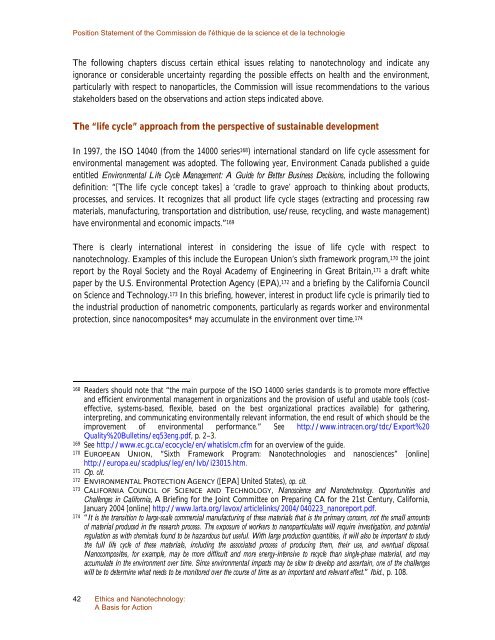A Basis for Action - Commission de l'éthique de la science et de la ...
A Basis for Action - Commission de l'éthique de la science et de la ...
A Basis for Action - Commission de l'éthique de la science et de la ...
Create successful ePaper yourself
Turn your PDF publications into a flip-book with our unique Google optimized e-Paper software.
Position Statement of the <strong>Commission</strong> <strong>de</strong> l'éthique <strong>de</strong> <strong>la</strong> <strong>science</strong> <strong>et</strong> <strong>de</strong> <strong>la</strong> technologie<br />
The following chapters discuss certain <strong>et</strong>hical issues re<strong>la</strong>ting to nanotechnology and indicate any<br />
ignorance or consi<strong>de</strong>rable uncertainty regarding the possible effects on health and the environment,<br />
particu<strong>la</strong>rly with respect to nanoparticles, the <strong>Commission</strong> will issue recommendations to the various<br />
stakehol<strong>de</strong>rs based on the observations and action steps indicated above.<br />
The “life cycle” approach from the perspective of sustainable <strong>de</strong>velopment<br />
In 1997, the ISO 14040 (from the 14000 series 168 ) international standard on life cycle assessment <strong>for</strong><br />
environmental management was adopted. The following year, Environment Canada published a gui<strong>de</strong><br />
entitled Environmental Life Cycle Management: A Gui<strong>de</strong> <strong>for</strong> B<strong>et</strong>ter Business Decisions, including the following<br />
<strong>de</strong>finition: “[The life cycle concept takes] a ‘cradle to grave’ approach to thinking about products,<br />
processes, and services. It recognizes that all product life cycle stages (extracting and processing raw<br />
materials, manufacturing, transportation and distribution, use/reuse, recycling, and waste management)<br />
have environmental and economic impacts.” 169<br />
There is clearly international interest in consi<strong>de</strong>ring the issue of life cycle with respect to<br />
nanotechnology. Examples of this inclu<strong>de</strong> the European Union’s sixth framework program, 170 the joint<br />
report by the Royal Soci<strong>et</strong>y and the Royal Aca<strong>de</strong>my of Engineering in Great Britain, 171 a draft white<br />
paper by the U.S. Environmental Protection Agency (EPA), 172 and a briefing by the Cali<strong>for</strong>nia Council<br />
on Science and Technology. 173 In this briefing, however, interest in product life cycle is primarily tied to<br />
the industrial production of nanom<strong>et</strong>ric components, particu<strong>la</strong>rly as regards worker and environmental<br />
protection, since nanocomposites* may accumu<strong>la</strong>te in the environment over time. 174<br />
168 Rea<strong>de</strong>rs should note that “the main purpose of the ISO 14000 series standards is to promote more effective<br />
and efficient environmental management in organizations and the provision of useful and usable tools (costeffective,<br />
systems-based, flexible, based on the best organizational practices avai<strong>la</strong>ble) <strong>for</strong> gathering,<br />
interpr<strong>et</strong>ing, and communicating environmentally relevant in<strong>for</strong>mation, the end result of which should be the<br />
improvement of environmental per<strong>for</strong>mance.” See http://www.intracen.org/tdc/Export%20<br />
Quality%20Bull<strong>et</strong>ins/eq53eng.pdf, p. 2–3.<br />
169 See http://www.ec.gc.ca/ecocycle/en/whatislcm.cfm <strong>for</strong> an overview of the gui<strong>de</strong>.<br />
170 EUROPEAN UNION, “Sixth Framework Program: Nanotechnologies and nano<strong>science</strong>s” [online]<br />
http://europa.eu/scadplus/leg/en/lvb/i23015.htm.<br />
171 Op. cit.<br />
172 ENVIRONMENTAL PROTECTION AGENCY ([EPA] United States), op. cit.<br />
173 CALIFORNIA COUNCIL OF SCIENCE AND TECHNOLOGY, Nano<strong>science</strong> and Nanotechnology. Opportunities and<br />
Challenges in Cali<strong>for</strong>nia, A Briefing <strong>for</strong> the Joint Committee on Preparing CA <strong>for</strong> the 21st Century, Cali<strong>for</strong>nia,<br />
January 2004 [online] http://www.<strong>la</strong>rta.org/<strong>la</strong>vox/articlelinks/2004/040223_nanoreport.pdf.<br />
174 “It is the transition to <strong>la</strong>rge-scale commercial manufacturing of these materials that is the primary concern, not the small amounts<br />
of material produced in the research process. The exposure of workers to nanoparticu<strong>la</strong>tes will require investigation, and potential<br />
regu<strong>la</strong>tion as with chemicals found to be hazardous but useful. With <strong>la</strong>rge production quantities, it will also be important to study<br />
the full life cycle of these materials, including the associated process of producing them, their use, and eventual disposal.<br />
Nanocomposites, <strong>for</strong> example, may be more difficult and more energy-intensive to recycle than single-phase material, and may<br />
accumu<strong>la</strong>te in the environment over time. Since environmental impacts may be slow to <strong>de</strong>velop and ascertain, one of the challenges<br />
will be to <strong>de</strong>termine what needs to be monitored over the course of time as an important and relevant effect.” Ibid., p. 108.<br />
42 Ethics and Nanotechnology:<br />
A <strong>Basis</strong> <strong>for</strong> <strong>Action</strong>
















